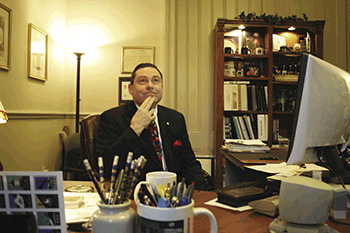One thing is certain about the effect of January’s fiscal cliff legislation, both enacted and pending – no one is certain what effect it will have on local investor behavior and nonprofit organizations’ bottom lines.
“There’s been a slight relief rally,” said Jeff Savage, regional chief investment officer with Wells Fargo Private Bank. “Investors are relieved that we didn’t go over the fiscal cliff, and that the measures weren’t draconian. But the markets – and small employers – are still in wait mode.”
Lance Boyce, a certified financial planner (CFP), registered principal of Cetera Advisor Networks and vice president at local investment advisory firm Boyce Financial Group, agreed that investors are “still hesitant,” and that the investment environment “still feels recessionary.”
On the other hand, Fisher Investments CEO Ken Fisher said that “investors have become a lot less frightened,” or, as Savage put it, “investors have reached ‘fear-fatigue.’”
“It’s as if all things are starting to feel like the boy crying wolf,” said Fisher. “Investors are in a mood to get on with their lives, even if the wolf is real.”
Investment geology
The truth is, said Boyce, that the fiscal cliff is only one feature in a complicated investment landscape. He cited lingering unemployment, high part-time employment, depressed incomes and new healthcare regulations as other investor concerns. Savage added that although the tax aspects of the fiscal cliff have been addressed, the spending aspect, including the sequestration (at least at press time) is still looming large.
“Investor sentiment is impacted by many factors,” said Fisher. “But it’s hard to tell what exactly is having the biggest impact.”
The good news, according to Fisher, is that “there is no measureable history of these things by themselves being big enough to move markets.”
In fact, added Savage, even with all the uncertainty in 2012, the U.S. market was up 16 percent, and he expects it to perform similarly in 2013.
Ron Entenman, an investment advisor with Columbia Credit Union’s wealth management division, said that there was “opportunity to see growth in the economy,” and that the fiscal cliff is only one of multiple things he looks at when considering how to position a portfolio.
“I look at the broader picture,” said Entenman. “Whether Republicans or Democrats are in office, the economy will ebb and flow.”
The take-away on charitable giving
The ramifications of the fiscal cliff deal on charitable donations are still unclear. Some fear that donations will decrease, while others see some positives. In a nutshell, a few of the tax ramifications that may be relevant to charitable donations include the following:
- For families with more than $450,000 in income, income tax, capital gains tax and estate tax rates increase.
- Itemized deductions (such as mortgage interest, state income tax and charitable donations) will no longer be fully tax deductible for families making over $300,000 (often referred to as the Pease limitation).
- 77 percent of Americans will pay about $700 more in taxes, mostly because of the elimination of the Social Security payroll tax holiday. (Forbes Magazine)
These effects, combined with forthcoming healthcare requirements, said Boyce, will mean investors – and charitable donors – will have less money. Whether that will translate to a decrease in donations remains to be seen.
Fisher said he was “shocked” that the Pease limitation has not been more publicized. He said that only about one in five of Fisher Investments’ high-income clients and prospects seem to currently understand the issue.
Alan Hamilton, executive director of Clark County Food Bank, said there was a flurry of donations at the end of 2012, while some contributors waited until January 1 to make their donations.
“There was definitely some energy being devoted to doing the right thing financially,” said Hamilton – whatever that might be.
Hamilton noted that he had a sense of a “reduction of income,” although he also said that agencies associated with feeding the hungry were usually less likely to see donation reductions.
“Food banks and other core compassion issues tend to be a high priority,” he said.
On the bright side, said Savage, since the top tax bracket increased from 35 percent to 39.6 percent, even non-fully deductible donations are essentially worth more to the taxpayer – raising the possibility that donations may increase at least for that tax bracket.
Elson Strahan, president and CEO of the Fort Vancouver National Trust, agreed with Savage.
“The tax savings from a charitable gift for individuals with state and federal tax brackets from 40 percent to 46 percent are now increased, so donors in higher income brackets may make larger gifts in 2013,” said Strahan.
Strahan also said that he has had a number of conversations with supporters that highlighted several provisions of the fiscal cliff legislation that “will be favorable for philanthropy.” These include the following:
- IRA charitable rollover opportunities have been extended through 2013
- Charitable remainder unitrusts and charitable remainder annuity trusts may be an attractive option, since they offer a much larger tax savings compared to merely disposing of major assets.
- Property gifts of appreciated land or stock by Subchapter S corporations is extended through 2013
As investors and charitable donors monitor and adjust to evolving developments, Entenman offered the following sound advice:
“I encourage clients to make more moderate moves, using cautious optimism and cautious pessimism. Do not let emotions take control of your finances – that is when people make the most mistakes.”









